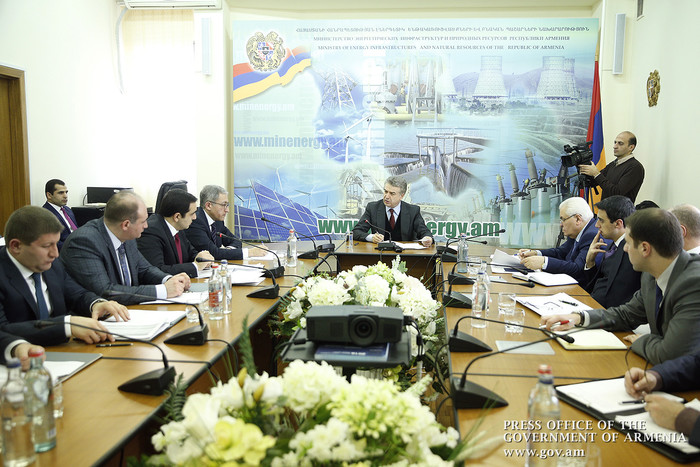 MINISTRY OF ENERGY INFRASTRUCTURES AND NATURAL RESOURCES OF THE REPUBLIC OF ARMENIA
MINISTRY OF ENERGY INFRASTRUCTURES AND NATURAL RESOURCES OF THE REPUBLIC OF ARMENIA

Today, Prime Minister Karen Karapetyan called at the Ministry of Energy Infrastructures and Natural Resources to get acquainted with the activities and priorities completed in 2017, as well as the tasks set for 2018..
Minister Ashot Manukyan reported that in order to ensure the country’s energy security, the Ministry has set the following tasks: increase the output of energy based on domestic alternative renewable energy sources to at least 50 percent of nationwide electricity consumption, reduce by least 20 percent the amount of gas used for power generating purposes at gas stations, and increase the share of nuclear energy by at least 10 percent, as well as to achieve higher level of nuclear power unit’s reliability through modernization.
For this purpose, the following activities have been implemented: under the State-private sector cooperation scheme, design and estimate works started for Shnogh hydroelectric power plant (76 MW initial capacity), which will fully use the Debed River’s untapped potential. Licenses for construction of 11 small solar power plants with a total capacity of 10 MW were provided. These are pilot projects, 3 of which are complete with the rest to be put into operation over the next 1-2 years. The tender for the construction of Masrik-1 solar station (rated capacity of 55 MW) has been announced, with its pre-qualification stage being passed by 10 companies with international reputation and experience. The competition will continue in 2018 to result in the selection of the main contractor. The Ministry estimates that the already completed Masrik-1 station will be put into operation in 2019.
With a view to ensuring the promotion of solar photovoltaic installations without licensing, the government has decided to raise the threshold of permitted capacity from 150 kilowatt to 500 kilowatt. As of February 1, 2018, currently 274 solar power stations with a total capacity of 2.8 MW.
36 small hydropower plants with a total installed capacity of 69 MW were licensed in 2017, which will be put into operation within the next 2-3 years. The solar power stations running on counter flows will reach the capacity of at least 10 MW in the next 2 years. In addition, in the coming years, the share of electricity produced from hydropower and solar plants will reach approximately 50% in domestic consumption.
According to the Minister, the second important problem is the reduction of gas consumption by 20% for the production of electricity at gas-operated power stations. Under the government-private partnership agreement, a contract was signed with the Italian Renco company and the design, and estimate work for construction of the second power unit of the Yerevan Thermal Power Plant was launched. Funding is made by the International Finance Corporation.
It is anticipated that the operational efficiency will reach 53%, which will reduce gas consumption at gas stations by the total average balance. In addition, the agreement signed last year with the American General Electric will kick off this year. Funding sources have already been identified, and the program of modernization of Yerevan TPP’s operating unit will be launched in June, as a result, efficiency will be 1.3% up and the production potential will increase by 7 MW. Due to these two events, Armenia will be able to reduce its gas consumption by 20 percent in the next 2-3 years.
In 2017, a program was successfully implemented, with all program indicators and timelines maintained, to extend the life of the ANPP 2nd unit, which started on September 20, 2016 with financing available from the Russian Federation.
The Government has approved and sent to the National Assembly the amendments to the Law on Energy that will promote the liberalization of the domestic market.
The construction of the 3rd 400-kV Iran-Armenia power transmission line resumed and continued in 2017. This year the basic equipment has been imported; activities are due to start this March, and the overhead transmission line will come to completion in 2019.
On December 18, 2017, an agreement was reached with KfW, the German Development Bank, for the construction of a 400 kV Armenia-Georgia power transmission line. The tender will be announced by March, 2018, and the main contractor will be identified in May and June. The Minister noted that taking into account the length of the line, the Armenia-Georgia transmission line will be completed in parallel with the Armenia-Iran line - by the end of 2019.
In 2017, an unprecedented increase was stated in the energy exports to Georgia and Iran within the framework of the Gas for Electricity program. Armenia took over the chairmanship of the International Atomic Energy Agency Board of Governors and submitted a bid to become a presiding country in the Energy Charter for the next 1-2 years. The application is under discussion.
In accordance with the Prime Minister’s instruction, a technical commission has been established to increase the reliability and efficiency of the energy system of Armenia, the main functions of which are as follows: technical policy and standards, introduction of chief engineer’s function in the energy system of Armenia, which will include discussion of all types of accidents and development of accident prevention programs.
The Commission’s task is also to concentrate on the preparation of autumn-winter cross-sectional activities in a single link and control, defining at the same time the relevant criteria, volumes and graphs.
Prime Minister Karapetyan attached importance to the provision of necessary conditions for effective implementation of technical policy.
Touching upon the issue of ensuring transparency in the mining industry, Manukyan presented the work on responsible mining and mining operations. For this purpose, three subdivisions of the Ministry have been merged into the unified Subsoil Agency and subsoil users can now benefit from the one-stop-shop principle.
In 2017, the Republic of Armenia joined the Extractive Industries Transparency Initiative, undertaking a number of commitments to ensure transparency in Armenia. All the passports (about 2 million pages) of mineral resources and information available in Republican Geological Fund SNCO have been digitized and are available at www.geo-fund.am.
The Government has approved and sent a package of legislative initiatives to the National Assembly, which states three main principles:
- Subsoil users undertake to make public in electronic form all information concerning the amounts extracted;
- With the proposed amendments to the Tax Code of the Republic of Armenia, the authorized State agencies undertake to publish through the appropriate electronic platform comprehensive information on all contributions and amounts paid by mining companies to the State budget and the budgets of local self-governing bodies. By doing so, all financial flows will be controlled by the public.
- Amendments to the Code of Administrative Offenses provide for liability and punishment for both the authorized government body and the subsoil user in the event of failure to comply with these obligations. It is anticipated that by this March 1, the Subsoil Agency will submit its development concept.
Pleased with the Ministry’s activities in 2017, Prime Minister Karapetyan noted that due to the imperative of the moment, efforts should be stepped up in all directions.
Deputy Minister Hayk Harutyunyan reported that in 2017 electricity production increased by 6.1 percent, consumption on the domestic market - 4.1 percent, energy exports - 17.1 percent, while gas imports rose 7.9 percent from Russia and 2.9 percent from Iran.
Karen Karapetyan highlighted the importance of increased energy flows and the formation of a regional energy hub.
“In fact, we have a good opportunity in the region. If we handle it flexibly, it is quite an exciting region with some complications - neighboring Iran, Iraq, Turkmenistan and Georgia with its surrounding areas. We will have 1-2 major regional players on this platform by 2020,” the Head of Government said, considering it necessary to take steps to build up capacity.
Deputy Minister Hayk Harutyunyan also reported on alternative energy sources: solar, wind energy development activities. According to him, within the framework of the project on geothermal power development and as part of the renewable energy project, a report has been drafted, referred to as “Cost estimate of Karkar geothermal power plant” and the translation of the report’s conclusion has been prepared.
At present, the package solution for geothermal power plant construction projects is being considered in Armenia with the involvement of a single investor for the Jermaghbyur and Karkar sites. Lat year a memorandum of understanding was signed with the Spanish ACCIONA Energy Global S.L. on construction of a wind power plant in Armenia.
The Memorandum of Understanding provides for the construction of 100-150 MW wind-powered stations in Armenia. The Company has started the assessment of the existing wind potential.
Deputy Minister Vardan Gevorgyan reported on the situation in the mining sector. 2017 26 permits for the extraction of minerals, 25 for non-metallic minerals, 1 for mineral waters, for geological surveys, 24 permits, 10 metal mines and 14 non-metallic minerals, 1 agreement for geological exploration, oil and gas exploration 2 licenses, one-time licenses for the export of mineral raw materials.
The Premier called the attention of the Ministry Staff to the importance of subsoil users’ discipline and, in this context, dwelt on to the licensing regulations: “We must closely monitor the discipline of our partners and understand how we can motivate the operators, considering that we have great potential for economic growth in this field.”